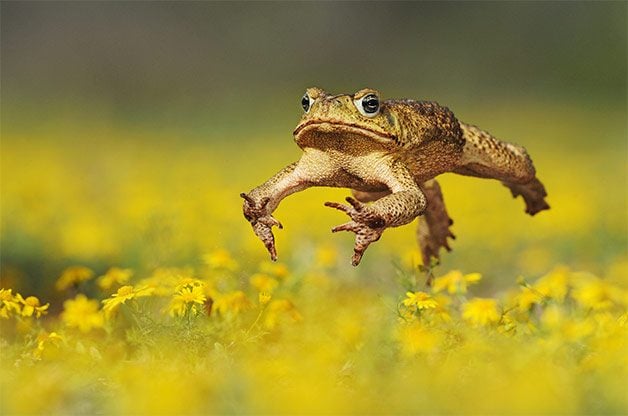Why Garden Toads are Valuable in the Backyard
Updated: Nov. 04, 2021

Learn more about garden toads, what toads eat, how to attract them, and why these amphibians are beneficial backyard guests.
When you think of garden wildlife, it’s likely that birds, butterflies and bugs come to mind first, but if so, you’re missing one of the most charming of creatures: the garden toad. Not only are they cute—in a lumpy, bumpy sort of way—they’re incredibly valuable in the backyard.
Frog or Garden Toad?
Toads are amphibians and closely related to frogs. There are about two dozen toad species in North America. Unlike aquatic frogs, toads are adapted to live in drier land environments. They have dry skin, rounded bodies, blunt noses and short legs that they walk on as often as hop. Most have tan, brown or gray coloration to blend in with soil, fallen leaves and rocks. Toads also have bumps on their skin. Contrary to myth, these aren’t warts. They are called paratoid glands and they produce toxins that protect toads from predators.
What Do Garden Toads Eat?
Toads are strictly carnivorous. They feed on beetles, slugs, crickets, flies, ants and other invertebrates. Larger toad species even eat small rodents and snakes. All toads will try to eat anything they can pull into their mouths and swallow. When it comes to natural pest control, you can’t do much better than a healthy toad population on your property.
Environmental Indicators
Toads, like all amphibians, are highly susceptible to environmental toxins. Their skin readily absorbs pesticides, chemical fertilizers and other
pollutants. If exposed to unhealthy levels of these things, amphibians can’t survive. If you have toads in your yard, it’s a good indication of a clean environment.
Learn how to create the ultimate backyard wildlife habitat.
Attract Toads to Your Yard
Although garden toads don’t rely on plants for food, they do benefit from them. Native plants offer habitats to natural insect populations, which are a toad’s main food source. Plants also provide toads with cover to hide from predators. A bare lawn won’t help attract toads, but natural garden beds filled with native plants will.
Create a brush or rock pile and leave a layer of fallen leaves to provide hiding places. Also, eliminate the use of chemical pesticides and fertilizers, which can kill toads outright and eliminate their prey. A clean water source is also necessary. Toads lay their eggs in shallow ponds, and without water, they can’t produce the next generation. In most cases, a water garden a foot or more deep will suffice. Place a small tree branch in the water, as well as aquatic vegetation, and let some leaves accumulate. Toads attach strings of their eggs to twigs and branches, and their tadpoles use the vegetation as hiding places. Start welcoming toads to your yard and enjoy the magic of listening to the trilling mating calls of male toads on warm spring nights.
Learn how to get rid of wasp nests in birdhouses without pesticides.
3 Ways to Create a Garden Toad Abode
Build toads a space of their own. Place your new toad home in a shady spot near a water source.
- Half-bury a large flowerpot on its side.
- Tip a flowerpot upside down and prop one side up with a few rocks to create an entrance.
- Gather flat rocks and build a toad-sized house with them.
